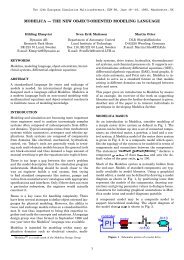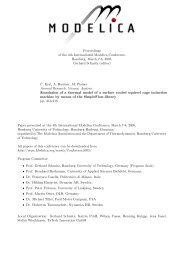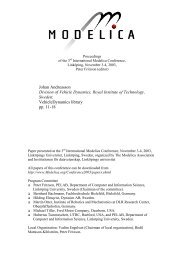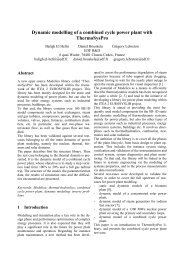Integration of CasADi and JModelica.org - Automatic Control
Integration of CasADi and JModelica.org - Automatic Control
Integration of CasADi and JModelica.org - Automatic Control
You also want an ePaper? Increase the reach of your titles
YUMPU automatically turns print PDFs into web optimized ePapers that Google loves.
which is also supported by the C collocation implementation<br />
in <strong>JModelica</strong>.<strong>org</strong>.<br />
5 Benchmarks<br />
Three different optimal control benchmark problems<br />
with different properties have been selected for comparison<br />
<strong>of</strong> the different algorithms: the Van der Pol oscillator,<br />
a Continuously Stirred Tank Reactor (CSTR)<br />
with an exothermic reaction, <strong>and</strong> a combined cycle<br />
power plant. The first bencmark, the Van der Pol oscillator,<br />
is a system commonly studied in non-linear control<br />
courses, <strong>and</strong> demonstrates the ability <strong>of</strong> all methods<br />
evaluated to solve optimal control problems. The<br />
CSTR problem features highly non-linear dynamics in<br />
combination with a state contstraint. The final benchmark,<br />
the combined cycle power plant, is <strong>of</strong> larger<br />
scale, consisting <strong>of</strong> nine states <strong>and</strong> more than 100 algebraics.<br />
Whereas the Van der Pol problem has been successfully<br />
solved using both multiple shooting <strong>and</strong> collocation,<br />
a solution to the CSTR <strong>and</strong> combined cycle<br />
problem has been obtained only using a collocation<br />
approach.<br />
For reference, the original collocation implementation,<br />
written in C, is included in the benchmarks. This<br />
algorithm is referred to as JM collocation.<br />
All the calculations have been performed on an Dell<br />
Latitude E6400 laptop with an Intel Core Duo processor<br />
<strong>of</strong> 2.4 GHz, 4 GB <strong>of</strong> RAM, 3072 KB <strong>of</strong> L2 Cache<br />
<strong>and</strong> 128 kB if L1 cache, running Linux.<br />
In the benchmarks where IPOPT is used, the algorithm<br />
is compiled with the linear solver MA57 from<br />
the HSL suite.<br />
5.1 Optimal control <strong>of</strong> the Van der Pol Oscillator<br />
As a first example, consider the Van der Pol oscillator,<br />
described by the differential equations<br />
x1 ˙ = x2, x1(0) = 1<br />
x2 ˙ = (1 − x 2 1)x2 − x1 x2(0) = 0.<br />
(2)<br />
The optimization problem is formulated as to minimize<br />
the following cost<br />
subject to the constraint<br />
20<br />
min x<br />
u 0<br />
2 1 + x 2 2 + u 2 dt (3)<br />
u ≤ 0.75. (4)<br />
Figure 3: Optimization results for the Van der Pol oscillator.<br />
First, we solve the optimal control problem using three<br />
different algorithms, all based on the Modelica model<br />
<strong>and</strong> the Optimica specification encoding the optimal<br />
control problem. 20 uniformly distributed control<br />
segements were used in all cases. The first method<br />
used to solve the problem is <strong>JModelica</strong>’s native, Cbased<br />
implementation <strong>of</strong> direct collocation, which relies<br />
on code generation <strong>and</strong> the AD-tool CppAD to<br />
generate derivatives. Secondly, the novel, <strong>CasADi</strong><br />
<strong>and</strong> Python-based implementation <strong>of</strong> direct collocation<br />
presented in Section 4 is applied. The third algorithm<br />
is ACADO Toolkit’s implementation <strong>of</strong> multiple<br />
shooting, using <strong>CasADi</strong>’s interface to evaluate<br />
functions <strong>and</strong> <strong>and</strong> directional derivatives. Forward<br />
mode AD was used to generate DAE sensitivities <strong>and</strong> a<br />
BFGS approximation <strong>of</strong> the Hessian <strong>of</strong> the Lagrangian<br />
<strong>of</strong> the NLP. The optimal solutions for the three different<br />
algorithms are shown in Figure 3.<br />
Table 1 shows the number <strong>of</strong> NLP iterations <strong>and</strong><br />
total CPU time for the optimization (in seconds) for<br />
5 different algorithmic approaches: direct collocation<br />
implemented in C <strong>and</strong> in Python using <strong>CasADi</strong>,<br />
ACADO Toolkit via the <strong>CasADi</strong> interface, <strong>and</strong> implementations<br />
<strong>of</strong> single <strong>and</strong> multiple shooting based on<br />
<strong>CasADi</strong>’s Python interface. The implementations <strong>of</strong><br />
single <strong>and</strong> multiple shooting are included to demonstrate<br />
usage <strong>of</strong> <strong>CasADi</strong>’s integrator <strong>and</strong> NLP solver<br />
implementation, rather than to achive high performance.<br />
For the single shooting code, the complete<br />
script was presented in Section 3.4.<br />
The last column <strong>of</strong> the table contains the share <strong>of</strong> the
















